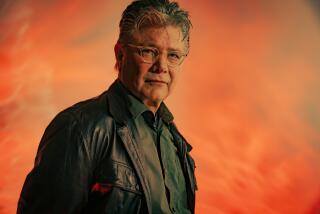A Second Look: Hal Hartley reestablishes âTrustâ
Once and briefly the brightest prospect in American independent cinema, writer-director Hal Hartley now seems more a forgotten man. Or perhaps a missing link between the indelible eccentricities of Jim Jarmuschâs pioneering films and todayâs more crowded (and more homogeneous) landscape.
Hartleyâs second film, and perhaps his most emblematic one, 1990âs âTrust,â is just out on DVD and Blu-ray from Olive Films, 22 years after it won Hartley the screenwriting prize at his old stamping grounds, the Sundance Film Festival.
His first feature, âThe Unbelievable Truth,â had made a splash â and sparked a minor bidding war â at the previous yearâs Sundance. A coming-of-age quasi-romance notable for its stylized performances and offbeat rhythms, it instantly established Hartley as a filmmaker with a distinctive voice.
PHOTOS: Hollywood backlot moments
Also shot in the Long Island suburbs, âTrustâ refined the template of âThe Unbelievable Truthâ and paired its lead actress, the late Adrienne Shelly, with Martin Donovan, who would become an axiomatic presence and a kind of alter ego for Hartley.
The opening sequence of âTrustâ deftly illustrates Hartleyâs default mode of off-kilter, absurdist tragicomedy. In a suburban kitchen, a teenage girl (Shelly) applies lipstick and argues with her parents, the camera isolating one of the three, keeping the other two out of frame or in the background. The father reacts to the casually dropped news of the girlâs pregnancy by dropping dead of a heart attack.
Hartleyâs signature is his deadpan dialogue, which often lapses into vaguely philosophical asides, but thanks in part to his cinematographer, Michael Spiller, his early films also share a visual poise and a gift for locating romance and mystery in mundane situations and settings.
Through the early â90s, Hartley worked quickly and with what now seems to be the unguarded confidence of youth. Each new film returned viewers to a familiar cosmos while expanding its horizons ever so slightly. âSimple Menâ (1992), a road movie of sorts that added genre-film complications, brought Hartley to the Cannes competition.
The amnesiac thriller âAmateurâ (1994) moved into urban settings and, capitalizing on Hartleyâs popularity in Europe, gave the French star Isabelle Huppert one of her most memorable English-speaking roles as a nun turned pornographer.
Put simply, Hartleyâs great contribution to independent cinema was his bold use of artifice, a tool that still unnerves most American filmmakers. His movies were an intervention into an indie film scene that often found itself mired in dreary, worthy naturalism. In stripping his neo-screwball comedies of all affect, he somehow made them both graver and funnier.
PHOTOS: Celebrity photos by The Times
Itâs not hard even now to see why Hartleyâs first few films, borrowing playfully from the American comic tradition (Sturgess, Keaton) as well as from French masters (Godard, Bresson), inspired a devoted cult. But it was a relatively brief heyday. Quentin Tarantino soon showed up on the scene, inspiring a legion of imitators.
Hartleyâs films have their descendants, but the oddball rom-coms that followed in his footsteps were rarely more than self-infatuated quirkfests and utterly lacked the purposeful strangeness of a film like âTrust.â (As a point of comparison, the next Long Island-set Sundance smash of the â90s was Edward Burnsâ tepid, thoroughly conventional âThe Brothers McMullen.â)
Meanwhile, Hartley seemed to be searching for a logical next step. The formalist experiment âFlirtâ (1995), which repeats the same story in three languages and three settings (New York, Tokyo, Berlin), made explicit his fondness for repetition. âHenry Foolâ (1997) inaugurated a new phase of his career by doing away with one of his defining traits â concision â and striving instead for mock-epic grandiosity.
As Hartleyâs attention drifted, so did his audience. The films became at once more varied in their ambitions and less persuasive. The Jesus parable âThe Book of Lifeâ (1998), the monster movie âNo Such Thingâ (2001) and âFay Grimâ (2006), a loose sequel to âHenry Fool,â have their sporadic charms. But for the most part they suggested that the gestures and devices he once deployed so artfully â flat dialogue, arch slapstick â had hardened into mannerism.
IN CASE YOU MISSED IT: Lance Armstrong, Oprah and recent TV apologies and confessions
A polymath who often composes his own scores, Hartley has nonetheless worked steadily on his films and on a wide array of projects, dabbling in theater and opera. He spent several years in Berlin researching a Simone Weil biopic and making short films.
Shot upon his return to New York, Hartleyâs most recent film, the hourlong âMeanwhile,â available on iTunes and through Hartleyâs company Possible Films (possiblefilms.com), represents something of a return to basics.
The story of a multi-tasking renaissance man who traverses the length of Manhattan on an errand, meeting people in need along the way, itâs a film about the value of soldiering on â and perhaps a kind of disguised autobiography for its still tireless and restless director.
PHOTOS AND MORE
VIDEO: The making of âArgo,â âLes Mizâ and more
ENVELOPE: The latest awards buzz
PHOTOS: NC-17 movies: Ratings explained
More to Read
Only good movies
Get the Indie Focus newsletter, Mark Olsen's weekly guide to the world of cinema.
You may occasionally receive promotional content from the Los Angeles Times.










